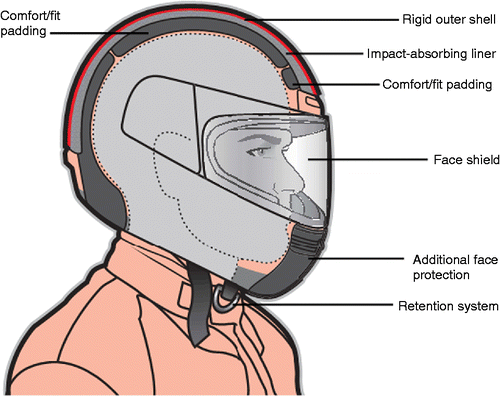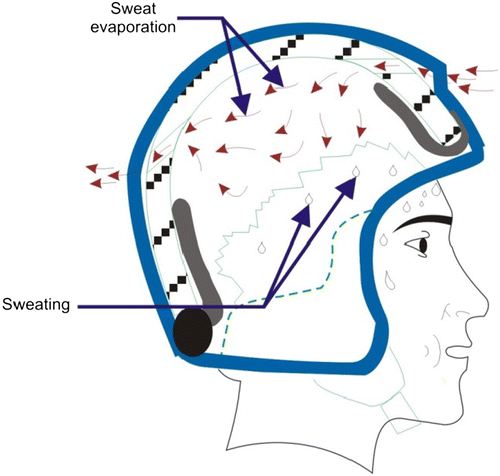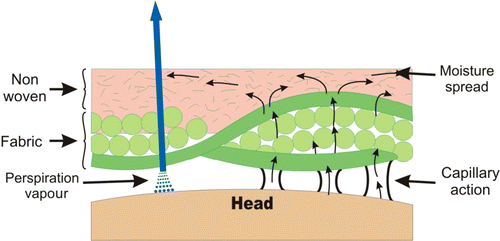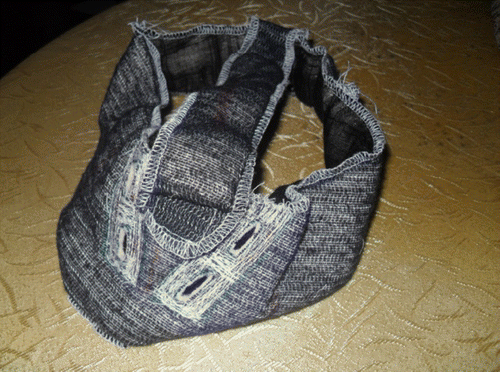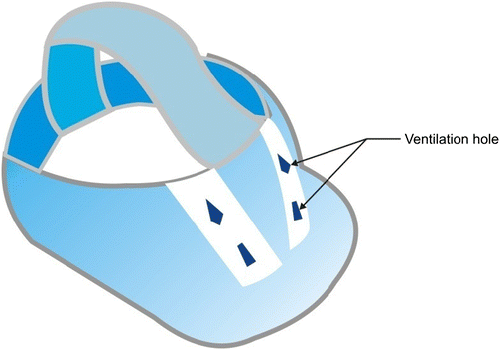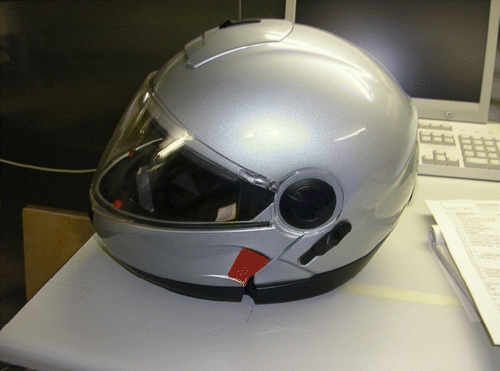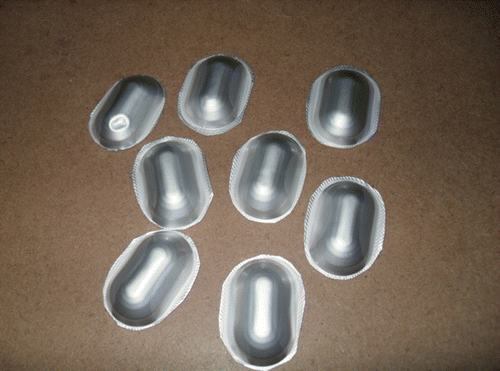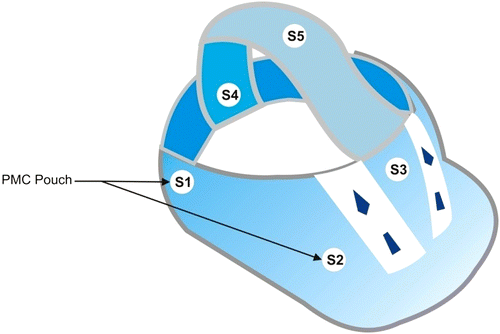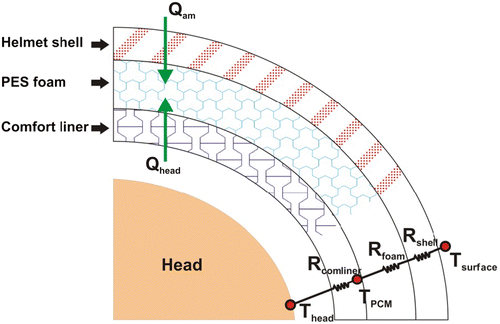Abstract
Natural fibres are nowadays increasingly being employed for producing protective clothing and sportswear. Due to economic and/or environmental considerations they are replacing synthetic materials. The present work provides an insight into the design and development of a novel comfort liner for a motorcycle helmet. The liner is produced from wool and Tunisian alfa fibre. The plant of the alfa fibre is abundantly available in Tunisia. Furthermore, we describe a design concept for a liner that uses these natural fibres and phase change material to improve sweat absorption and perception of thermal comfort. The raw material, the processes involved and the solution to use the phase change material are analysed. The novel comfort liner can facilitate breathability and evaporative transfer of heat in the safety helmet. In addition, it increases comfort, well-being, and provides an indirect message to use natural fibres for textile support to preserve our environment.
1. Introduction
Environment protection, and thus ecological solutions, has become one of the most important challenges faced by the product design industry and community. At the same time, there is a clear demand by the consumer for environment friendly textiles, but often without an increase in the normal price. Moreover, consumers are becoming increasingly conscious of the comfort provided by garments that they are wearing. As a result, new fibres and fabrics are emerging to satisfy consumer needs (Hadj Taieb et al. Citation2010).
In the case of protective wear, safety helmets are intended to protect the head against impact or objects falling from a height. However, in the hot and humid climate such as that in Tunisia, many workers and motorcycle drivers are less willing to wear helmets. This is because they feel uncomfortable (ANE Citation2007). Thermal discomfort caused by high ambient temperatures has been thoroughly researched. To improve helmet usage, many suggestions to improve design have been proposed. For instance, ventilation holes are shown to intensify forced and evaporative convection (Reischl Citation1986, Fonseca Citation1997, Hsu et al. Citation2000). Other characteristics of helmets, such as reflective materials, colour and general construction, have been examined and selected to optimise heat transfer from the human head to the environment (Abeysekera and Shahnavaz Citation1988, Liu and Holmer Citation1995). Abeysekera et al. (Citation1991) showed that suggestions in the studies that have been mentioned have led to some improvements in the design of protective headwear.
In addition, helmet materials such as expanded polystyrene and polycarbonate shell, must be of specified thickness. This is of importance for providing sufficient protection in case of impact. The modification of the thickness could significantly compromise helmet safety. Therefore, to optimise the heat transfer in the helmets, the issue of the comfort liner should be addressed. A comfort liner is a layer that resides between the head and the expanded polystyrene layer. XD spacer fabrics are being widely used to replace foam in the comfort liner of a helmet. Their main advantages are breathability, insulation compression strength and pressure distribution. Currently, the spacer fabric from natural fibres is not commercialised, which can influence consumer choice. In addition, synthetic fibres are not hydrophilic; thus moisture sorption is limited only to the capillary action (XD Spacer Fabric Citation2011).
In this context, we designed an ecological comfort liner using, on one hand, natural fibres and, on the other hand, phase change material (PCM) as a helmet cooling system. It is suggested that such a product could be used by designers and engineers who wish to deliver ‘green’ product choice that can enhance any sustainable design.
2. Helmet components
A helmet usually consists of three primary elements: the outer shell, an impact liner and a comfort liner (Figure ). The tough outer shell protects the head by evenly dispersing forces across the inner impact layer. The impact liner absorbs most of the impact energy by deforming upon impact. Finally, the comfort liner provides a snug and comfortable fit over the wearer's head (MSF Citation2002).
3. Heat and moisture transport mechanism in helmet
The head is a major body area for heat removal. The heat that is gained or lost from the head can be dry and/or evaporative. When a helmet is worn, dry heat is removed by convection (through the helmet shell and the space between the helmet shell and the head), conduction and radiation. Dry heat transfer through conduction is a very small component of the heat transfer process. Heat transfer by evaporation follows the same pattern as convection. Evaporation of the heat from the head takes place by the evaporation of sweat produced on the head (Figure ). When the sweating area of the head is covered, evaporation is considerably reduced.
For security reasons, the protective helmet shell is impermeable to both solids and liquids, and consequently prevents perspiration vapour transfer. Evaporative heat transfer can be improved only when the helmet has good ventilation options such as ventilation holes on the helmet shell and breathable comfort liners (Abeysekera and Shahnavaz Citation1988, Abeysekera et al. Citation1991).
4. Factors affecting moisture transport in the helmet
When the helmet is worn, the moisture transfer rate is low. Consequently, the relative and absolute humidity levels of the microclimate will increase, thus suppressing evaporation of the sweat. The perception of discomfort depends on the degree of skin wetness. The perspiration vapour from the head can be transferred across the comfort liner leaving the microclimate by ventilation and forced convection. On the other hand, for liquid sweating, the mechanism by which the drops of sweat are transported in textiles is similar to that of wicking of liquid in capillaries. The volume rate at which a liquid moves through a porous channel is related to the driving force by Poiseuille's law (Das et al. Citation2007):
The capillary action is determined by two fundamental properties of the capillary which are its diameter and surface energy of its inside face. The smaller the diameter or the greater the surface energy, the higher is the tendency of a liquid to move up the capillary. Hence, the narrower the spaces between fibres and yarns, the greater is the ability of the textile to wick moisture (Das et al. Citation2007).
5. Design of helmet comfort liner
In this study, several eco-design strategies were taken into account when the helmet comfort liner was designed. In particular, optimal service life, durability, reduced energy consumption and natural fibre use were considered. Moreover, we applied PCM to improve the thermal comfort of a helmet wearer.
A comfort liner is typically placed between the impact absorption material and the head of the helmet wearer. The liner is generally made of urethane foam, covered with (cloth) nylon webbing. In contrast, the proposed comfort liner is composed of two parts: a knitting fabric and a non-woven fabric (Figure ). The choice of material was crucial in this study as we incorporated ecological constraints and material functional properties.
5.1 Fabric choice
The capillary diameter mainly depends on the type of fibre and textile construction. To improve the tendency of a liquid to move upwards and the ability of the textile to wick moisture, the spaces between fibres and yarns can be reduced by using microfibres. Moreover, with a bonding jersey, the capillary diameter is minimized and the picked up capillary moisture is improved.
On the other hand, surface energy is determined largely by the chemical structure of the exposed surface of the fibre. In addition, hydrophilic fibres have a high surface energy. Consequently, they pick up moisture more readily than hydrophobic fibres, which have a low surface energy and repel moisture. However, hydrophilic fibres are rapidly saturated with moisture during sweating. Therefore, a discomfort can be reported. For these reasons, polyester fibres are chosen for the fabric.
5.2 Lining choice
5.2.1 Material
Non-woven is a structure that consists of a web of fibres joined by chemical or mechanical means (Russell Citation2006). On account of ecological constraints and material functional properties, the polyurethane foam liner was replaced by a needle-punched non-woven liner, which was based on Tunisian alfa fibre and wool. Alfa fibres are extracted from the plant Stipa tenacissima, or esparto grass (alfa is the Arab name for esparto). The plant grows in the dry regions of North Africa: Tunisia, Morocco, Algeria, Libya and in south Europe in Spain (Paiva et al. Citation2007). The choice of natural fibre such as alfa fibre and wool has several benefits. Wool and alfa fibres are hygroscopic and they easily absorb moisture. Wool fibre is known to absorb one-third of its own weight of moisture and leaves the wearer comfortable. A liner from these fibres can be laundered according to wool-specified instructions because it is more sensitive than vegetable fibre (Eberle et al. Citation1999).
5.2.2 Liner characterization
Characterization of the standard and proposed liner is done according to the ISO standard. This includes the characterization of thickness (ISO 98631) and weight per unit area (ISO 9073). Furthermore, air permeability was determined according to the ISO 9237 standard and is defined as the speed of an air flow passing perpendicularly through a sample under conditions of surface test, and pressure losses. The adiathermic property can be defined as the ability of the fabric to withstand the heat and it was measured using NF G O7-107. The water vapour resistance is defined as the vapour pressure difference per unit times rate of water vapour steady-state flow through a unit area, normal to specific parallel surfaces. It was measured according to the ISO 11092 standard. For comparison among the liners, all the data for each property were collected in a randomised design. The data were subjected to ANOVA and the means were separated using Tukey's studentised test (Table ).
Table 1 Liners characterisation.
5.2.3 Liner form and preparation
Prepared non-woven comfort liners were sewn taking into consideration the helmet size and other comfort constraints (Figure ). Specifically, the form of a liner depended on the helmet form and its ventilation channels (Figures and ). In addition to these constraints, the curvature of the bulb portions are designed in a manner that allows fitting of a liner on different heads. Namely, the cushioning strip can be completely adapted to fit the user, without any complex fitting arrangements.
Furthermore, the design provides a series of ventilation openings through the liner. These ventilation openings are well spaced with respect to a crown of the wearer and the helmet ventilation channels. Thus, the geometry of the liner was designed for optimal comfort by providing infinite adjustability and ventilation.
5.3 The use of PCM
5.3.1 What is PCM
PCM possesses the ability to change its physical state within a certain temperature range. When the melting temperature is attained during a heating process the phase changes from the solid to the liquid state. During this process, the PCM absorbs large amount of latent heat from the surrounding areas. This heat is then stored in the PCM and is subsequently released in a cooling process starting at the PCM's crystallisation temperature. During the entire phase change process, the temperature of the PCM as well as the surrounding substrate remains constant. When the phase change is complete, continued heating/cooling results in a further temperature increase/decrease (Pause Citation2003).
5.3.2 Thermal comfort with PCM
Brühwiller (Citation2003), Liu and Holmer (Citation1995) and Hickling (Citation1986) indicated that wearing a helmet impacts heat transfer properties due to the insulating properties of the helmet materials. In addition, energy absorption materials protect the head, but also significantly increase insulation due to the required thickness. Thus, heat that is typically transferred via convection or radiation to the surrounding environment is retained inside the helmet, increasing the surface temperature of the skin and head.
In the present study, a helmet cooling system that uses PCM in the comfort liner is investigated. The aim is to absorb all the heat generated from the head at a relatively constant temperature to provide cooling to the head. Consequently, the temperature of the helmet microclimate is maintained close to the melting temperature of the PCM and creates a thermally comfortable environment. In the comfort liner, the PCM is enclosed in a pouch and placed in different locations on the top of the head. When the skin temperature is above the melting temperature of the PCM, the PCM begins to melt as it absorbs the heat from the head. It is expected that the breathability of comfort liner will not be largely affected since the aluminium pouch area represents only about 7% of the total liner area.
5.3.3 Solution for better integration of PCM into helmet comfort liner
Tan and Fok (Citation2006) presented a design approach that uses the PCM as a cooling system for safety helmets. Lack of this solution was the uncontrolled added weight that the consumer had to support on his head. We propose to place PCM pouches in the comfort liner (Figure ). Therefore, the consumers can easily control the added weight with their capacity. An example of a comfort liner with a cooled system is provided in Figure . Specifically, we propose to place a PCM pouch in different locations on the comfort liner. Consequently, the PCM weight can be distributed equally on the head's surface. Each PCM part is stored in a flexible aluminium foil to avoid the leak of a melting polymer. Furthermore, an aluminium foil is chosen because it has high thermal conductivity (Figure ). Seven pouches are sewn in the comfort liner to place the aluminium pouches: S1–S7 (S6 and S7 are the symmetries of S1 and S2) (Figure ). The pouch has large heat transfer surface area to shorten the discharging time. The thickness of the pouch is minimal so that it does not affect liner flexibility and tactile comfort.
5.3.4 PCM choice and required quantity
Different PCMs are widely available in the market. The selection depends mainly on the polymer melting temperature (Table ). The heat generated by the wearer's head is about 116 W/m2 (Tan and Fok Citation2006), producing about Q head = 15 W for an average-sized head. In addition, heat flows from the head through the thermal resistances of the cushion and comfort liner to the PCM in the pouch. The helmet is heated up by the hot ambient air and also through skin friction heating by the air flowing across the surface of helmet. Thus, a certain amount of heat, Q am, flows from the ambient through the surface of the helmet, the shell foam and into the PCM. The surface temperature of the helmet is estimated to be T surface = 45°C.
Table 2 Phase change materials.
In our liner we use the octadecane polymer, which has a melting temperature of 28.2°C, crystallisation temperature of 25.4°C and a heat storage capacity of 244 J/g (67.77 Wh/kg). The amount of PCM required to maintain the helmet microclimate of about 28°C over a loading time of 20 min was calculated, taking into account the different liner thermal resistances (Figure ), i.e. shell thermal resistance R shell, foam thermal resistance R foam and comfort liner thermal resistance R comliner (Equations Equation2-4)):
6. Discussion
To optimise the thermal comfort of a helmet wearer, two approaches were chosen: (1) optimisation of sweat absorption and liner breathability and (2) reduction of heat stress using a cooling system that can be implemented in a conventional helmet liner.
Results indicate that novel liners have higher air permeability and lower water vapour resistance compared to the standard liner (Table ). Such characteristics are suggested for the improvement of the breathability of a liner, thereby improving the microclimate of a helmet and the cooling provided by evaporation. Furthermore, results of the assessed adiathermic properties indicate that standard liner is the first that opposes and stores the heat that crosses the helmet (Table ). The embedded PCM cooling system in the proposed liners is shown to provide cooling of the microclimate for about 20 min without the use of an external power supply. Since the required PCM quantity is fixed in the comfort liner, the helmet wearer can easily control the added weight within his capacities.
The limitation of the PCM used is that the stored heat in the PCM needs to be discharged before it can be used again. Thus, we suggest that the usage of the PCM can be increased using PCMs with a higher heat storage.
7. Conclusion
This paper describes a design concept for a helmet comfort liner designed to avoid the risk of heat stress during the use of the helmet. Furthermore, attempts were made to meet functional needs that the consumer desires through the use of ecological textile materials, an ecological process and natural materials.
We designed a textile product taking into account thermal and moisture transfer. Tunisian alfa fibre and wool were used to make a non-woven fibre, which replaces polyurethane foam to enhance the use of a natural fibre. Air permeability and water vapour resistance of the proposed liner and standard liner were compared. Results indicate that the proposed liner can improve breathability and evaporative heat transfer. To assure the thermal comfort of a helmet wearer, PCM pouches were placed in the liner as a helmet cooling system.
Acknowledgement
The authors acknowledge the technical advice, English help and support received from Niels and Nina Bogerd.
Notes
References
- Abeysekera , J.D.A. and Shahnavaz , H. 1988 . Ergonomics evaluation of modified industrial helmets for use in tropical environments . Ergonomics , 31 : 1317 – 1329 .
- Abeysekera , J.D.A. , Holmer , I. and Dupois , C. 1991 . “ Heat transfer characteristics of industrial safety helmets ” . In Towards human work: solutions to practical problems in occupational health and safety , Edited by: Kumashiro , M. and Megaw , E.D. 297 – 303 . London : Taylor and Francis .
- Agence nationale de la maitrise de l'énergie (ANE), 2007. Situation de la mobilité en Tunisie. No. 3, 12–17
- Brühwiller , P.A. 2003 . Perspiring manikin headform for the measurement of headgear ventilation characteristics . Measurement Science and Technology , 14 : 217 – 227 .
- Das , B. 2007 . Moisture transmission through textiles, Part II: evaluation methods and mathematical modelling . AUTEX Research Journal , 7 ( 3 ) September 2007
- Eberle , H. , Hermeling , H. and Hornberger , M. 1999 . Technologie de vêtement , Montreal : Guerin . ISBN 2-7601-5401-7
- Fonseca , G.F. 1997 . Physiological factors in protective helmet design , 61 – 77 . Natick, MA : US Army Research Institute of Environmental Medicine . Publication USARIEM -M-
- Hadj Taieb , A. , Msahli , S. and Sakli , F. 2010 . Design concept for an ecological relaxing textile product using solar energy . International Journal of Sustainable Engineering , 3 ( 2 ) : 133 – 142 .
- Hickling , E.M. 1986 . Factors affecting the acceptability of head protection at work . Journal of Occupational Accidents , 8 : 193 – 206 .
- Hsu , Y.-L. , Tai , C.Y. and Chen , Y.S. 2000 . Improving thermal properties of industrial safety helmets . International Journal of Industrial Ergonomics , 26 : 109 – 117 .
- Liu , X. and Holmer , I. 1995 . Evaporative heat transfer characteristics of industrial safety helmets . Applied Ergonomics , 26 : 135 – 140 .
- Motorcycle Safety Foundation (MSF), 2002. What you should know about motorcycle helmet. Final Report. February 2002. Available from: www.msf_usa.org [Accessed 16 July 2011]
- Paiva , M.C. 2007 . Mechanical, morphological and interfacial characterization . Composites Science and Technology , 67 : 1132 – 1138 .
- Pause , B. 2003 . Nonwoven protective garments with thermo-regulating properties . Journal of Industrial Textiles , 33 ( 2 ) : 93 – 99 .
- Reischl , U. 1986 . Fire fighter helmet ventilation analysis . American Industrial Hygiene Association Journal , 47 ( 8 ) : 546 – 551 .
- Russell , S.J. 2006 . Handbooks of nonwoven , Boca Raton, FL; Boston, MA; New York; Washington, DC; Cambridge, England : The Textile Institute and Woodhead Publishing Limited .
- Tan , F.L. and Fok , S.C. 2006 . Cooling of helmet with phase change material . Applied Thermal Engineering , 26 : 2067 – 2072 .
- XD Spacer Fabric, 2011. Baltex. Available from: http://www.baltex.co.uk/french/xd_spacer_fabrics.html [Accessed 31 March 2011]
